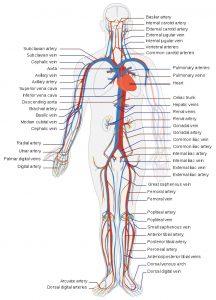Organisms have different forms of circulatory systems. Humans have a closed circulatory system, while many mollusks and other invertebrates have an open system. In a closed circulatory system, blood is enclosed within blood vessels.
The following image is a diagram of the closed circulatory system in a human.
| Closed Circulatory System | Open Circulatory System | |
| Blood enclosed in vessels | Yes | Not always |
| Blood reaches cells by | Diffusing through membranes | Leaving vessels |
| Example organisms | All vertebrates including humans | Insects, most mollusks, Hydra |
Open Circulatory Systems
Open circulatory systems are common to most arthropods and mollusks. They have a heart that pumps blood into a hemocoel. The blood then diffuses back into the blood vessels.
Tissues tend to be surrounded by blood, and the blood flows freely throughout the body tissues. In this type of circulatory system, blood tends to be sluggish because it is diffusing rather than readily being pumped through vessels.
Animals with an open circulatory system tend to be small organisms, so the blood doesn’t have far to travel. These animals typically have low metabolisms. They don’t tend to need quick energy or immune defenses.
Closed Circulatory Systems
In a closed circulatory system, the blood stays within blood vessels. In this way, blood is kept separate from body tissues. This system has a heart that pumps blood through a continuous circulation pattern. As such, the blood tends to be pumped at a higher pressure.
In organisms with a closed circulatory system, the blood does not fill body cavities. Many vertebrates, such as humans, have a circulatory system known as the cardiovascular system and a secondary system known as the lymphatic system.
Animals with a closed circulatory system tend to be larger than those with an open circulatory system—consider, for example, an elephant versus a grasshopper. This type of system can transport blood to extremities while maintaining a higher blood pressure than the open circulatory system.
There are several different heart configurations for an animal with a closed circulatory system. Most mammals have a four-chambered heart, which separates the oxygenated blood from the deoxygenated blood. A fish has a two-chambered heart, which pumps blood directly to the gills to become oxygenated and then throughout the body. Amphibians have three-chambered hearts, where oxygenated and deoxygenated blood mix within the heart before being pumped to the body.

